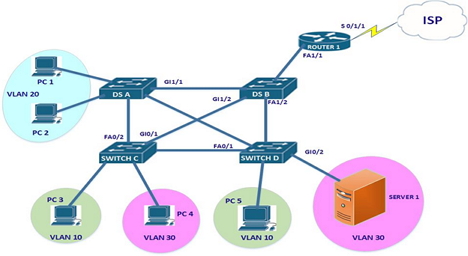As you start to prepare for your various Cisco certifications, one thing you will notice about Cisco exams is they are not the easy multiple choice type questions that you will see with the CompTIA A+ exams or the such. That is why the Cisco certification holds so much more weight with employers and provides you a better chance of landing a well-paying job than a CompTIA certification. Thus you will see questions on your CCNA or CCENT exam that makes you string together multiple concepts to be able to select the correct answer. They often provide you with information overload! In our sample CCNA practice exam scenario question we have here today, you can see this in action.
It is typical that you will see a topology similar to the sample below on your Cisco Certified Network Associate 200-120 CCNA exam. This question brings together the concepts of switching, VLAN (virtual LANs, STP (Spanning Tree Protocol) and redundancy all in one. Ensuring that you understand how each relate to the other. So let’s jump into the question below.
Using the topology exhibit below, you are a CCNA administrator. One of the CCNP network engineers has had reports of network connectivity issues and he has asked you to solve the problem for him since he is unavailable at this time. It is suspected that the cable connected to switch port Fa0/1 on SwitchD is disconnected. What would be an effect of this cable being disconnected?
A. PC 1 would not be able to access the server in VLAN 30 until the cable is reconnected.
B. Communication between VLAN30 and the other VLANs would be disabled.
C. For less than a minute, PC 3 would not be able to access the server in VLAN 30. Then normal network function would resume.
D. The transfer of files from PC 2 to the server in VLAN 20 would be significantly slower.
EXPLANATION
Spanning Tree Protocol (STP) is a loop prevention in a redundant switched network by ensuring that there is only one logical path between all destinations on the network by intentionally blocking redundant paths that could cause a loop. The switch sends BPDUs (Bridge Protocol Data Units) out every active port once every 2 seconds so as to find a redundant link. Redundant links are found when the switch receives its own BPDU. When a switch discovers a link is down, a redundant link or a blocked link that is available to that network is unblocked and traffic resumes to normal.
Answer A is incorrect as PC1 would more than likely be traversing the link from DS A to Switch D. So that is not the answer. Answer B is incorrect as a disconnected cable in a fully redundant topology such as this would be resolved via STP as already noted. Answer C is correct as the primary link that PC 3 would be using from Switch C to Switch D would be the link that is disconnected. After it unblocks redundant links and reconverges, you would have a normal functioning connectivity again. Finally answer D is incorrect as the speed would not be reduced as suggested by answer D.
Want to replicate the topology above at your house? Not sure of how to create a top notch lab to prepare you for your CCNA certification lab? Then check this out! helpful lab suggestions here.
If you already know how to create your very own customized CCNA lab, click the link below to get started!

